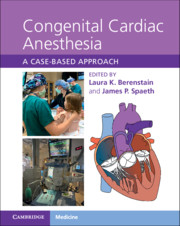Book contents
- Congenital Cardiac Anesthesia
- Congenital Cardiac Anesthesia
- Copyright page
- Dedication
- Contents
- Contributors
- Introduction
- Chapter 1 A Congenital Heart Disease Primer
- Section 1 Left-to-Right Shunts
- Section 2 Right-Sided Obstructive Lesions
- Section 3 Left-Sided Obstructive Lesions
- Section 4 Complex Mixing Lesions
- Section 5 Single-Ventricle Physiology
- Section 6 Heart Failure, Mechanical Circulatory Support, and Transplantation
- Chapter 31 Duchenne Muscular Dystrophy
- Chapter 32 Dilated Cardiomyopathy
- Chapter 33 Mixed Cardiomyopathy
- Chapter 34 Extracorporeal Membrane Oxygenation
- Chapter 35 Left Heart Ventricular Assist Device
- Chapter 36 Right Ventricular Assist Device
- Chapter 37 Lung Transplantation
- Chapter 38 Post Orthotopic Cardiac Transplantation
- Chapter 39 Failing Cardiac Transplant
- Section 7 Miscellaneous Lesions and Syndromes
- Index
- References
Chapter 38 - Post Orthotopic Cardiac Transplantation
from Section 6 - Heart Failure, Mechanical Circulatory Support, and Transplantation
Published online by Cambridge University Press: 09 September 2021
- Congenital Cardiac Anesthesia
- Congenital Cardiac Anesthesia
- Copyright page
- Dedication
- Contents
- Contributors
- Introduction
- Chapter 1 A Congenital Heart Disease Primer
- Section 1 Left-to-Right Shunts
- Section 2 Right-Sided Obstructive Lesions
- Section 3 Left-Sided Obstructive Lesions
- Section 4 Complex Mixing Lesions
- Section 5 Single-Ventricle Physiology
- Section 6 Heart Failure, Mechanical Circulatory Support, and Transplantation
- Chapter 31 Duchenne Muscular Dystrophy
- Chapter 32 Dilated Cardiomyopathy
- Chapter 33 Mixed Cardiomyopathy
- Chapter 34 Extracorporeal Membrane Oxygenation
- Chapter 35 Left Heart Ventricular Assist Device
- Chapter 36 Right Ventricular Assist Device
- Chapter 37 Lung Transplantation
- Chapter 38 Post Orthotopic Cardiac Transplantation
- Chapter 39 Failing Cardiac Transplant
- Section 7 Miscellaneous Lesions and Syndromes
- Index
- References
Summary
Approximately 55% of infants <1 year of age listed for heart transplantation have complex congenital heart disease. In contrast, 44% to 54% of older children listed for transplantation have cardiomyopathy, with the percentage transplanted for congenital heart disease decreasing steadily with increasing patient age. Graft failure, rejection, infection, and coronary allograft vasculopathy are all major causes of death within the first 5 years post-transplant. Due to the interruption of the cardiac plexus and the inability for conduction to cross suture lines, the autonomic nervous system efferent limbs are compromised. The resting heart rate of a transplanted patient is generally higher compared to the normal innervated heart but maintains similar minimum and maximum rates. The normal response to exercise and stress occurs at a delay compared to the innervated heart, as it follows the gradual increase in serum catecholamines, which takes several minutes to generate. This chapter details the perioperative considerations for and management of a patient post heart transplant presenting for noncardiac surgery.
Keywords
- Type
- Chapter
- Information
- Congenital Cardiac AnesthesiaA Case-based Approach, pp. 290 - 298Publisher: Cambridge University PressPrint publication year: 2021



